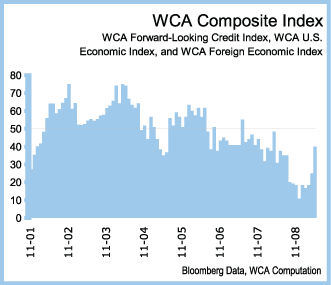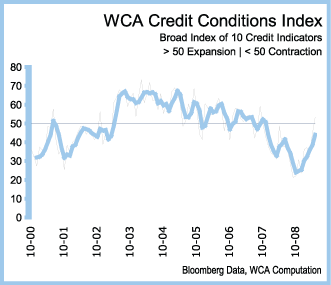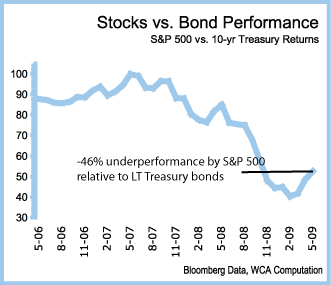Signs of Improvement
Broadening Out Portfolios & Raising Equity
Exposure
Since our last commentary, we have seen signs of improvement
in a variety of economic indicators (see WCA Economic
Conditions Index), above and beyond the improvement already
seen in the supply indicators of credit (see WCA Credit
Conditions Index). In no particular order, we have seen:
1. a rise in some commodity prices;
2. an improvement in confidence;
3. a slowdown in jobless claims;
4. stabilization in the inventory-to-sales ratio; and
5. signs of increased overseas activity.

.png)

It is difficult to see whether these "green shoots" will grow
deeper roots, or die from the economy's chill in the months
ahead. Despite these improvements, we are aware of the
complexities brought about by over-indebtedness, de-leveraging,
monetization of massive amounts of new Federal debt, and high
levels of government involvement in private sector business.
These all introduce new levels of uncertainty into the investing
equation that cannot be easily understood or anticipated. That
said, we must recognize the good with the bad, and investment
decisions must take all relevant facts into account.
Therefore, we have decided to increase our exposure to equities
(both foreign and domestic) primarily within the growth
categories (technology, consumer discretionary, healthcare)
which are performing better and tend to be less levered than
most value sectors. We also add corporate debt (both high grade
and high yield), and add foreign government bonds (both
developed and emerging market). We are utilizing some of our
cash, Treasury bills, Treasury bonds, and gold positions as
sources of funds to make these investments. As the result of
these changes, our tactical portfolio recommendations will have
a higher equity position, but remain below the midpoint of our
target ranges for equity exposure pending further developments.
Before the market lows of March, risk investment in equities had
underperformed full "faith and credit" U.S. Treasury bonds by
63% from July 2007. The equity market's recent
improvement from the March lows, coupled with a backing up of
long-term interest rates, narrows this margin of
underperformance to 46% (see chart). By either measure,
this large re-pricing of risk has been consistent with the
enormity of the challenges that have confronted, and will
continue to confront, the economy. Nonetheless, such a
correction ranks among the largest re-pricings of risk seen in
U.S. financial history.

In this corrective process, the equity risk premium has
risen sharply. This can be seen when comparing the
trailing 12-month S&P 500 "earnings yield" (or inverse of the
price-to-earnings ratio) to the yield offered on 10-year U.S.
Government Treasury Bonds. At present, this difference (called
a spread) is 2% higher (200 basis points) for the equity "yield"
than the yield offered on the Treasury (see chart). This level
has not been seen since 1980, and while it can go higher (as was
the case in the 1970s), the purchase of S&P 500 earnings is
today more attractive than the purchase of long-term Treasuries
based on a comparison of current yields. However, the important
question is, “What kind of recovery can we expect in S&P 500
earnings in a post credit bubble environment?”
.png)
We expect to see a slow earnings recovery
starting in 2010-2011. We now expect $51
in 2009 S&P operating earnings; $54 in 2010 earnings (5%
growth); $65
in 2011
operating earnings in 2011 (22% growth); and $84 in 2012 (24% growth).
Using the current S&P 500 index level of approximately 950, we
estimate that the U.S. equity market now trades at 18.5X 2009
earnings, with earnings expected to grow at 15% over the next
four years. A link to a spreadsheet containing our full set of
assumptions can be found
here.
Our assumptions underlying our forecast are:
1) The most severe part of the recession is behind us;
that 2010 will begin a transition toward gradual recovery; and
by 2011, the economy will be well beyond the current period of
negative growth. We place the odds of recession lingering
through 2010 at less than 50% and have no expectation for
recession to continue beyond 2010.
2) A slow process of recovery in employment, output, and
profits will emerge from the initial early signs of
recovery that we have identified in our economic and credit
analysis (as discussed above). This recovery will be typified
by higher unemployment and lower profitability than earlier
cycles because:
1.
the percentage of employment in government and socialized fields
will most likely continue to expand relative to private sector
employment;
2.
the capacity for expansion of private sector debt and credit are
fading;
3.
demographic shifts in the age of the population are underway;
and
4.
highly cyclical sectors such as manufacturing continue to shrink
from cycle to cycle.
Hence, the level of “full employment” in recovery may well be
less than in previous cycles, and the sharp “snap backs” in
labor trends may not repeat themselves in this recovery as they
have in most post-war recoveries. Under these special
circumstances, our initial assessment is that we see contracting
nominal GDP this year (of 1-3%), a return to muted-but-positive
(1-2.5%) growth in the transitional 2010-2011 timeframe, and a
“new normal" growth rate of 3-5% not returning until 2012.
3) We expect further top-line pressure on profits
as further de-leveraging in the economy mutes the normally sharp
earnings recovery that typically follows recessions. While
bottom-line results have been beating estimates due to
cost-cutting, top-line results still seem to be falling below
most analysts’ expectations. While inventory and cost-cutting
provide some positive support to earnings, challenges in
generating top-line growth lead us to conclude that pre-tax
corporate profits will likely return to a range of 6-10% of GDP
rather than the 12-15% levels which were experienced during the
credit and commodity boom of recent years. Currently, corporate
profits as a percent of GDP stand at 9.5%.
4) A key assumption is that the tax burden on
corporations remains steady. Here, we have chosen to
assume no increase in corporate profits until we learn more
about the legislative agenda for this in 2010. While it is
likely that corporate tax rates will prove to be an appealing
political target, it is far too soon to assess whether this
issue is ultimately a viable one given economic conditions. As
of the last period, after-tax corporate profits amounted to
roughly 78% of pre-tax profits according to National Income and
Product Account data.
Beyond the assumptions affecting operating earnings, several
considerations must be made given the special nature of bank
write-offs. Recently, the International Monetary Fund estimated
that total bank write-offs around the world will near $3
trillion. However, global banks have only recognized $1.5
trillion in losses and raised only $1.3 trillion in new capital,
according to Bloomberg data. Thus, we find it difficult to say
that we are completely out of the woods and anticipate that
additional hits are likely to be taken as more foreclosures in
residential real estate surface, as commercial real estate
losses are made evident, and as asset prices that back loan
portfolios continue to slip.
Against these challenges, more liberal mark-to-market
accounting, high lending margins, renewed investor interest in
bank secondary equity offerings, and some improvement in
depressed asset-backed security and credit markets offer some
near-term sense of stability for the banks. It would not
surprise us if there are even some near-term improvements in the
accounting measure for assets at some banks.
Foreign assets have outperformed U.S. dollar-denominated assets
in recent weeks, and the dollar sell-off was echoed in U.S.
Treasury markets. A zero-interest rate policy coupled with
significant new borrowings by the United States to fund these
deficits are contributing factors to dollar weakness. At the
same time, inflationary expectations have increased in
anticipation of the monetization of this debt. Under these
circumstances, it would not surprise us to see global capital
seek a more diversified "basket" of investments in other
currencies and assets to be held alongside existing dollar
assets.
For more clarity on debt and deficits, we look to the
Congressional Budget Office (CBO). According to the CBO, debt
held by the public will increase to 82% of GDP by 2019 from 57%
of GDP today under current spending plans. If we add in new
guarantees and obligations of companies in conservatorship (not
to mention under-funded entitlement programs and state
deficits), the fiscal "house" of the United States has
deteriorated markedly. One cause of the expected increase in
Federal debt burden is increased Federal spending relating to
"stimulus." The CBO now estimates that the new budget will
produce deficits of $1.7 trillion (11.9 percent of gross
domestic product, or GDP) this year and $1.1 trillion (7.9
percent of GDP) next year. These deficits will be the largest
deficits as a share of GDP since 1945 and the largest peacetime
deficits in history. Whatever the cause, these deficits must be
financed through taxes and borrowing — both of which have
negative implications for the dollar.
The most important factor (and most difficult to understand and
forecast) is the level of prices as seen through the value of
the dollar. We have seen a marked and historic shift away from
the private sector acting as the economy's borrower of last
resort. The Federal government is now taking up that role.
While it might seem odd that we need a "borrower of last resort"
at all, the fact is that the supply of money is dependent on
having willing borrowers. This is because the monetary
structure of the economy is tied to debt. Bank credit
(deposits) is the primary form of money in the modern economy,
and these deposits result from new borrowings. The retirement
of debt, on net, will produce a drain of the same. Hence, the
new drive for debt pay-down in the private sector, either
through defaults or early retirement, is a drain on the
availability of money and produces downward pressure on prices.
If falling prices become the expected outcome, it is
difficult to get spending and investing back on track, and the
economy can remain mired in a prolonged slump.
In 2002, Ben Bernanke explored the deflation problem and
concluded that, "under a paper money system, a determined
government can always generate higher spending and, hence,
positive inflation.” This was a very telling statement, because
it reminds us that the Fed, by itself, cannot bring about
inflation through the direct printing of money. It suggests
that only in "partnership" with Congress and other investors is
the Fed capable of converting government-issued debt into new
dollars that could prevent dollars and bank credit from
contracting. Therefore, the Fed Chair’s statement assumes that
there will be both a commitment by government to expand debt at
a rate sufficient to offset private sector contraction and that
foreign investors will remain committed to buying and holding
their dollar assets. It is far too early to assess
whether or not the Fed will be successful in their undertaking
to create just the right amount of inflation.
Recently, there has been a sharp increase in commodity prices in
both the industrial and precious metal markets. Gold prices
have crossed above $950 an ounce, silver has just had its
strongest monthly return since 1987, and the Commodity Research
Bureau's index of commodities is 25% higher than February. This
suggests monetary inflation, especially as stockpiles of oil and
other commodities remain curiously high. At the same time, the
decline in the trade-weighted dollar seems to be calling out for
the Fed to raise interest rates. Again, this suggests monetary
inflation. The difference in yield between the 10-year Treasury
and the 10-year Inflation Protected Treasury bond has risen to
nearly 2% from 0%. Again, this is another potential indication
of monetary inflation. And, lastly, the "term spread" or
difference between 3-month bond yields and 10-year bond yields
has risen to 345 basis points (3.45%) which are near record
highs. All of this is suggesting not only monetary inflation,
but that the Fed is now "in a box" on interest rates. They
appear “boxed in” because they cannot respond to inflationary
signals for fear of undoing improvements they have seen to date
and, at the same time, they are limited in the use of
traditional policy tools (setting short-term interest rates and
changing reserve requirements) because these policy tools have
already been exhausted. Instead of being focused on the
longer-term inflationary impact of large-scale debt
monetization, we believe that Fed policy is more focused on:
1.
the "output gap" (the economy is running well below potential
output);
2.
the lack of inflationary wage and employment trends;
3.
potential new losses in commercial real estate and consumer
credit; and
4.
a new and large wave of Option ARM and ALT-A mortgage resets.
Therefore, they will be forced to continue down the road of
direct purchases and guarantees of a wide variety of assets that
were once considered too risky for the Fed to own under past
governance. The long-run effects of these programs (both good
and bad) are unknown, but it is our sense that the Fed will find
it difficult to withdraw from these programs now that market
participants have come to expect Fed involvement in these
markets. These observations, together with a lack of hawkish
language from the Fed, suggest to us that Fed policy will remain
on the current track for some time to come, and the dollar to
remain relatively weak.
There has been improvement in our credit and economic "diffusion
indices." Market-based indicators suggest fading deflationary
pressure, along with some improvement in economic activity.
These improvements come on top of government-sponsored
improvement in the supply conditions for credit. At the same
time, there has been some improvement in the relative
performance between stocks and bonds, but the equity risk
premium still suggests a potentially attractive entry point for
equities from a historic perspective (assuming that the
economy and earnings continue to improve from here).
We still have concerns about what the quality of the recovery
will ultimately be, but believe it is appropriate to add some
exposure to equities and broaden out portfolios to include
foreign assets and corporate bonds, given recent improvement in
our indices. We continue to see relatively better performance
from growth sectors such as technology, healthcare, and consumer
discretionary over value sectors.
These changes are subject to change in either direction
depending upon the progression of inputs on the economy from
this point going forward. We may add or reduce exposure to
assets based on the relative performance of those assets and
changes to the macro-economic environment as demonstrated though
our various economic indicators. We will continue to monitor
and update you on the progress of the economy and our
recommendations as we track progress from here. |
Past Commentaries
March 13, 2009
A Big Hit to Wealth and What to Do Now?
More
March 5, 2009
A Questionable Plan and a Free Market Silver Lining?
More
January 7, 2009
Can Policymakers Create Just a Little Inflation?
More
December 11, 2008
Household Credit Turns Negative...
More
November 21, 2008
Credit: Don't Want It... Can't Get It...
More
September 24, 2008
Downgrading Outlook Based on Credit Freeze
More
September 15, 2008
Equity Markets Stumble on Lehman, Merrill, and AIG
More
September 9, 2008
No Change In Strategy On GSE Action
More
July 31, 2008
Quick Take on GDP Report
More
July 21, 2008
Valuation Are Better, But Markets Are Not Out of the
Woods
More
May 20, 2008
Buy the Dips
More
March 10, 2008
Investing During Recession
More
January 22, 2008
Global Sell-off
More
December 27, 2007
Outlook 2008
More
December 7, 2007
NBER President Raises Recession Concerns
More
November 28, 2007
Equity Risk Heightened - Allocation Remains Defensive
More
September 25, 2007
After the Rate Cut
More
July 30, 2007
The Case For Growth
More
June 15, 2007
Data Affirms Tactical Asset Allocation Posture
More
March 19, 2007
Cutting Earnings And Equity Target
More
| |